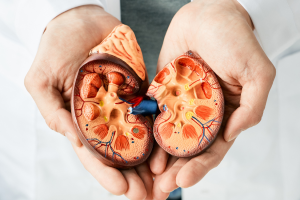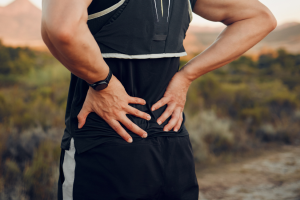Kidney Stones
 Kidney stones affect millions of people each year, causing significant pain that many feel is the worst pain they’ve ever experienced. While it’s hard to imagine, some say that their kidney stones hurt more than the pain they experienced during childbirth. So, how does a kidney stone form, and why does it hurt so much?
Kidney stones affect millions of people each year, causing significant pain that many feel is the worst pain they’ve ever experienced. While it’s hard to imagine, some say that their kidney stones hurt more than the pain they experienced during childbirth. So, how does a kidney stone form, and why does it hurt so much?
Kidney stones are complex salt and mineral deposits that form inside your kidneys. They usually build when urine becomes too concentrated with minerals, such as uric acid, oxalates, and calcium, and they combine to form hard stones. Left untreated, they form larger and larger masses within the kidney – a snowball effect of sorts. Some stones remain in the kidney and grow, typically asymptomatic in their earlier manifestations. Other kidney stones move out from the kidney and get lodged in the ureter, the tube that connects the kidneys to the lower urinary tract, like the bladder. These ureteral stones create the most significant pain, while stones within the kidney are generally less painful (until they are much larger).
The most common symptom is severe pain in the side of the abdomen and back. However, referred pain can be felt in other areas as well. The pain occurs not because of the size of the stone or its jagged edges but instead because it blocks urine flow and starts to distend the kidneys. This pain often continues until the stones have passed or been removed via one of the procedures discussed below. That said, some patients stop feeling kidney stone pain even if they haven’t passed the stone. The absence of pain does not mean that the stone is gone or no longer a problem; as such, patients should always see their urologist if they believe they have a kidney stone.
Causes of Kidney Stones
Kidney stone development is rarely due to a single environmental cause but a combination of factors. Genetics also increases your likelihood of developing them. Here are some of the most common causes of kidney stones:
Foods High in Oxalate
Eating a diet high in nuts (almonds and cashews), chocolates, and specific fruits and vegetables, such as spinach, rhubarb, baked potatoes, and beets, increases the ingestion of oxalates. Additionally, drinking soda can increase your risk because sodas have high levels of phosphate, which contributes to kidney stone formation. Limiting your intake of these foods can reduce your risk.
Animal Protein
A diet rich in animal protein, such as chicken, eggs, and seafood, can reduce citrate levels, which is necessary to prevent the formation of kidney stones. Eat a well-balanced diet so you don’t increase your risk of kidney stone formation.
A Sodium Diet
The more sodium you eat, the more calcium your body retains. Therefore, reducing your salt intake can help reduce your risk of developing kidney stones. Avoid sodium-rich foods like bacon, highly processed sauces, table salt, canned soup, and fast food.
Lack of Fluid Intake
One of the most effective preventive measures against the development of kidney stones is drinking a lot of water. Lack of fluid intake can lead to uric acid stones, especially if you have a high-protein diet. This works because liquids dilute the mineral content in urine enough to prevent them from sticking together and solidifying. Water is excellent for flushing out your system. Aim to drink 64+ ounces of water daily and even more if you work out or it’s particularly hot or cold outside.
And a Myth
Looking at a kidney stone under a microscope, you will see that it is often jagged and can be very hard, depending on its composition. While there are varied kidney stone formations, the stone’s properties do not cause pain. Instead, the kidney stone blocks normal urine flow through the ureter and creates a backup of urine that causes the kidney to swell. It is this additional pressure within the kidney that causes the searing pain.
It’s also important to understand that kidney stones can become problematic if not treated early. First, the backup of urine is a breeding ground for bacteria. Patients who develop an infection behind their kidney stones can experience disruptions in kidney function and even kidney failure. Left untreated, an infection can cause sepsis and severe medical ramifications, including death.
How common are kidney stones?
Kidney stones are prevalent, particularly in what is known, for better or worse, as a stone belt. This area of the southeastern United States experiences hot and humid conditions for most of the year—and yes, we’re in it! Ultimately, kidney stones generally form because patients do not drink enough, and as such, their urine tends to stagnate and crystallize.
How are kidney stones diagnosed?
Kidney stones can often be diagnosed simply by understanding a patient’s medical history and current symptoms. Many patients who have had kidney stones will experience them again and know exactly what they have. If kidney issues are suspected, depending on the severity of symptoms and the location of their pain, patients may be referred to imaging, including ultrasound or more advanced imaging.
What are the treatment options for kidney stones?
 There are several treatment options for kidney stones, but many pass them naturally or with the help of medications. However, a kidney stone lodged in the urinary tract can cause complications. In this situation, your urologist may recommend a procedure to remove the stone. Let’s take each of these options one by one.
There are several treatment options for kidney stones, but many pass them naturally or with the help of medications. However, a kidney stone lodged in the urinary tract can cause complications. In this situation, your urologist may recommend a procedure to remove the stone. Let’s take each of these options one by one.
If the kidney stone is relatively small – 4 mm or less – it may be passed in the urine. Only time will tell if this is the case, so it’s important to be under the guidance and supervision of your urologist to ensure that it doesn’t get any worse. We ask patients to look for small fragments of stone that come out in the urine. Without visual confirmation, we cannot be sure that the stone has been passed. In some patients, the exceptional pain caused by kidney stones can decrease, even if the stone has not been passed. If not treated, and there is significant obstruction, there can be serious consequences.
Drinking as much as 2 to 3 quarts (1.9 to 2.8 liters) daily can help flush out your urinary system. If your doctor approves, drink enough fluid — mostly water — to produce clear or nearly clear urine. Unfortunately, passing a small stone can cause some discomfort. Your doctor may recommend pain relievers such as ibuprofen, acetaminophen, or naproxen sodium (all found in over-the-counter pain reliever products) to reduce pain. If your pain is severe, your doctor may give you a medication known as an alpha-blocker to relax the muscles in your ureter and help pass the kidney stone more quickly and with less pain.
ESWL – extracorporeal shockwave lithotripsy
ESWL is an exciting and non-invasive kidney stone treatment that uses shockwaves outside the body to break up smaller, softer stones. While the patient is under anesthesia, upwards of 2500 shockwaves are directed precisely toward the stone to break it into smaller pieces and allow it to pass naturally. ESWL is an excellent option for softer stones, but we cannot be sure that the stone has been entirely pulverized because we do not have direct visualization. As such, while most patients will experience relief, there is a higher possibility that stones will reform in the future. ESWL is ideal for kidney stones located within the kidney and may be appropriate for some lodged in the ureter, though it is not commonly used for ureteral formations.
Learn More About ESWL
Ureteroscopy with laser lithotripsy
Ureteroscopy involves inserting a ureteral scope through the urethra, past the bladder, and up the ureter. This can be a flexible or rigid tube with a camera on the end that allows the urologist to visualize the stone. Once visualized, Dr. Natale can deploy laser (concentrated light energy) or mechanical energy to break up the stone and allow it to pass. Ureteroscopy also enables your urologist to use a small collection bag to grasp any pieces of kidney stone that may not pass on their own. The improved visualization that ureteroscopy gives us means it is more likely to get patient, stone-free, though there is always some risk of fragments remaining.
Learn More About Ureteroscopy
PCNL percutaneous nephrolithotomy
Lastly, and most invasively, is percutaneous nephrolithotomy or PCNL. PCNL is used for large or difficult-to-access stones located in the kidney. Unlike other forms of kidney stone treatment, PCNL is surgery. A day or two before the procedure, a radiologist will place an access in the patient’s back – a port or cannula that gives direct access into one of the fingers of the kidney. At this point, under general anesthesia and in the hospital, Dr. Natale will surgically remove the stone, again potentially using laser or mechanical energy. PCNL is used only for stones within the kidney and not the ureter. PCNL virtually guarantees a stone-free result.
Learn More About PCNL
The importance of being stone-free
You may ask why it’s crucial that patients be stone-free after their kidney stone procedure. To understand this, we must think about a snowball effect. As a snowball rolls down a snowy hill, it collects more snow and becomes larger and larger until it becomes a massive boulder, which becomes dangerous. The same is true for a kidney stone. The longer the kidney stone remains within the kidney, even if it is relatively small at the time, the more additional material will eventually bind to it, creating a larger stone that is more complex to treat. Being stone-free gives a patient the best chance of avoiding recurrence in the future, though lifestyle changes are also needed to help ensure this outcome.
